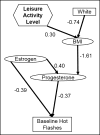Understanding the complex relationships underlying hot flashes: a Bayesian network approach
- PMID: 28763402
- PMCID: PMC5771829
- DOI: 10.1097/GME.0000000000000959
Understanding the complex relationships underlying hot flashes: a Bayesian network approach
Abstract
Objective: The mechanism underlying hot flashes is not well-understood, primarily because of complex relationships between and among hot flashes and their risk factors.
Methods: We explored those relationships using a Bayesian network approach based on a 2006 to 2015 cohort study of hot flashes among 776 female residents, 45 to 54 years old, in the Baltimore area. Bayesian networks were fit for each outcome (current hot flashes, hot flashes before the end of the study, hot flash severity, hot flash frequency, and age at first hot flashes) separately and together with a list of risk factors (estrogen, progesterone, testosterone, body mass index and obesity, race, income level, education level, smoking history, drinking history, and activity level). Each fitting was conducted separately on all women and only perimenopausal women, at enrollment and 4 years after enrollment.
Results: Hormone levels, almost always interrelated, were the most common variable linked to hot flashes; hormone levels were sometimes related to body mass index, but were not directly related to any other risk factors. Smoking was also frequently associated with increased likelihood of severe symptoms, but not through an antiestrogenic pathway. The age at first hot flashes was related only to race. All other factors were either not related to outcomes or were mediated entirely by race, hormone levels, or smoking.
Conclusions: These models can serve as a guide for design of studies into the causal network underlying hot flashes.
Conflict of interest statement
The authors have no conflicts to declare.
Figures




Similar articles
-
Hormone variability and hot flash experience: Results from the midlife women's health study.Maturitas. 2019 Jan;119:1-7. doi: 10.1016/j.maturitas.2018.10.007. Epub 2018 Oct 23. Maturitas. 2019. PMID: 30502745 Free PMC article.
-
Smoking, body mass, and hot flashes in midlife women.Obstet Gynecol. 2003 Feb;101(2):264-72. doi: 10.1016/s0029-7844(02)02593-0. Obstet Gynecol. 2003. PMID: 12576249
-
Risk factors for hot flashes among women undergoing the menopausal transition: baseline results from the Midlife Women's Health Study.Menopause. 2015 Oct;22(10):1098-107. doi: 10.1097/GME.0000000000000434. Menopause. 2015. PMID: 25783472 Free PMC article.
-
Menopausal hot flashes and development of cognitive impairment.Ann N Y Acad Sci. 2005 Jun;1052:11-26. doi: 10.1196/annals.1347.002. Ann N Y Acad Sci. 2005. PMID: 16024747 Review.
-
Risk factors for hot flashes in midlife women.J Womens Health (Larchmt). 2003 Jun;12(5):459-72. doi: 10.1089/154099903766651586. J Womens Health (Larchmt). 2003. PMID: 12869293 Review.
Cited by
-
Urinary phthalate metabolite concentrations and hot flash outcomes: Longitudinal associations in the Midlife Women's Health Study.Environ Res. 2023 Jan 1;216(Pt 2):114576. doi: 10.1016/j.envres.2022.114576. Epub 2022 Oct 14. Environ Res. 2023. PMID: 36252832 Free PMC article.
-
Urinary phthalate metabolite concentrations and hot flashes in women from an urban convenience sample of midlife women.Environ Res. 2021 Jun;197:110891. doi: 10.1016/j.envres.2021.110891. Epub 2021 Mar 17. Environ Res. 2021. PMID: 33722529 Free PMC article.
-
Urinary phthalate metabolite concentrations and serum hormone levels in pre- and perimenopausal women from the Midlife Women's Health Study.Environ Int. 2021 Nov;156:106633. doi: 10.1016/j.envint.2021.106633. Epub 2021 May 15. Environ Int. 2021. PMID: 34004451 Free PMC article.
-
Nocturnal Hot Flashes, but Not Serum Hormone Concentrations, as a Predictor of Insomnia in Menopausal Women: Results from the Midlife Women's Health Study.J Womens Health (Larchmt). 2023 Jan;32(1):94-101. doi: 10.1089/jwh.2021.0502. Epub 2022 Nov 25. J Womens Health (Larchmt). 2023. PMID: 36450126 Free PMC article.
-
Study on a Bayes evaluation of the working ability of petroleum workers in the Karamay region, Xinjiang, China.Front Psychol. 2022 Oct 10;13:1011137. doi: 10.3389/fpsyg.2022.1011137. eCollection 2022. Front Psychol. 2022. PMID: 36300051 Free PMC article.
References
-
- Goodman NF, Cobin RH, Ginzburg SB, Katz IA, Woode DE. AACE Medical Guidelines for Clinical Practice for the Diagnosis and Treatment of Menopause. Endocr Pract. 2011;17:1–25. - PubMed
-
- Smith RL, Gallicchio LM, Miller SR, Zacur HA, Flaws JA. Risk Factors for Extended Duration and Timing of Peak Severity of Hot Flashes. PLoS One [Internet] 2016;11(5):e0155079. Available from: http://dx.plos.org/10.1371/journal.pone.0155079. - DOI - PMC - PubMed
-
- Avis NE, Crawford SL, Greendale G, Bromberger JT, Everson-Rose Sa, Gold EB, et al. Duration of Menopausal Vasomotor Symptoms Over the Menopause Transition. JAMA Intern Med [Internet] 2015;27157(4):531–9. Available from: http://archinte.jamanetwork.com/article.aspx?doi=10.1001/jamainternmed.2.... - PMC - PubMed
-
- Fisher TE, Chervenak JL. Lifestyle alterations for the amelioration of hot flashes. Maturitas [Internet] 2012;71(3):217–20. Available from: http://dx.doi.org/10.1016/j.maturitas.2011.12.006. - DOI - PubMed
Publication types
MeSH terms
Substances
Grants and funding
LinkOut - more resources
Full Text Sources
Other Literature Sources

